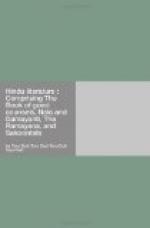“Il est beau en effet. Sa taille est haute, mais quelques-uns la trouveraient mince; sa chevelure noire est bouclee et tombe jusqu’a la nuque; ses yeux noirs sont profonds et bien fendus; le front est noble; la levre superieure, couverte par une moustache naissante et noire, est parfaitement modelee; son menton a quelque chose de severe; son teint est d’un blanc presque feminin, ce qui denote sa haute naissance.”
In this description we seem to recognize some Surya or Soma of Hindoo mythology, and the final touch, meaningless as applied to a European, reminds us that in India whiteness of skin has always been a sign of aristocratic birth, from the days when it originally distinguished the conquering Aryas from the indigenous race of the Dasyous.
As a literary composition “Mlle. D’Arvers” deserves high commendation. It deals with the ungovernable passion of two brothers for one placid and beautiful girl, a passion which leads to fratricide and madness. That it is a very melancholy and tragical story is obvious from this brief sketch of its contents, but it is remarkable for coherence and self-restraint no less than for vigor of treatment. Toru Dutt never sinks to melodrama in the course of her extraordinary tale, and the wonder is that she is not more often fantastic and unreal.
But we believe that the original English poems will be ultimately found to constitute Toru’s chief legacy to posterity. These ballads form the last and most matured of her writings, and were left so far fragmentary at her death that the fourth and fifth in her projected series of nine were not to be discovered in any form among her papers. It is probable that she had not even commenced them. Her father, therefore, to give a certain continuity to the series, has filled up these blanks with two stories from the “Vishnupurana,” which originally appeared respectively in the “Calcutta Review” and in the “Bengal Magazine.” These are interesting, but a little rude in form, and they have not the same peculiar value as the rhymed octo-syllabic ballads. In these last we see Toru no longer attempting vainly, though heroically, to compete with European literature on its own ground, but turning to the legends of her own race and country for inspiration. No modern Oriental has given us so strange an insight into the conscience of the Asiatic as is presented in the story of “Prehiad,” or so quaint a piece of religious fancy as the ballad of “Jogadhya Uma.” The poetess seems in these verses to be chanting to herself those songs of her mother’s race to which she always turned with tears of pleasure. They breathe a Vedic solemnity and simplicity of temper, and are singularly devoid of that littleness and frivolity which seem, if we may judge by a slight experience, to be the bane of modern India.




